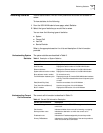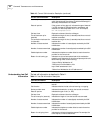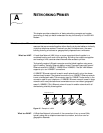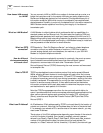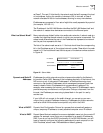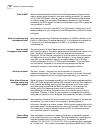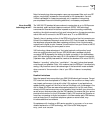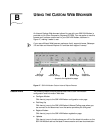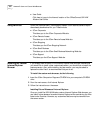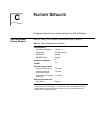
98 APPENDIX A: NETWORKING PRIMER
What is NAT? Network Address Translation, also known as IP address sharing, allows multiple
users to share a single connection, such as an Internet connection. For example,
with the 56K LAN Modem, when any user on the LAN launches a Web browser
for Internet access, their computer’s IP address is translated into the IP address
provided by the ISP for access. This allows multiple users on your LAN to appear as
one connection to your ISP.
You probably do not want to use NAT If your LAN network is static; that is, an IP
address is assigned to your computer by your MIS department or ISP and manually
configured.
What are numbered and
unnumbered links?
Some networks require an IP address to be assigned to a WAN in addition to the
LAN(s). If a WAN has an IP address assigned to it, it is considered a numbered link.
If there is not an IP address assigned to a WAN, it is considered to be an
unnumbered link.
How is overall
throughput determined?
The performance of all linked devices must be considered to determine
end-to-end throughput. Connection performance is affected by each device in the
chain. Therefore, the slowest link in the chain determines the maximum
throughput. On the LAN side, computers on a typical network can communicate
with each other at up to 10 Mbps. When dialing up to a long distance location
using 56K, you can establish a network connection speed of up to 56 Kbps
without compression or up to 115.2 Kbps with compression. If you are dialing
into the Internet, the speed of the router providing access must also be
considered. In addition, the Internet itself may have speed limitations.
What is a modem? The word “modem” is derived from the combination of two words:
modulator/demodulator. The main function of a modem is to convert the analog
signal of the telephone line into the digital signal required by your computer.
What is the difference
between analog and
digital signals?
Digital information is processed according to two finite states, expressed as either
ON or OFF. Digital signals are therefore often referred to as binary. Most telephone
lines, however, are analog, meaning that their signals are continuously varied
along fluctuating rates and values. Before the advent of online services, the
primary use for the telephone network was for transferring voice traffic,
accomplished by converting the spoken voice into an electric signal of varying
frequencies. Therefore, in order for your computer to understand the incoming
analog data, a translation must take place; this is essentially the task of a modem.
What is error correction? Error correction is a method by which modems verify the integrity of the data they
are receiving. If an error is found, the corrupted or damaged packet of
information, referred to as a frame, is resent. While this may impose a delay on the
transmission speed, the data across the connection will be nearly 100% error-free.
The current error correction standard is known as V.42. It is the most common
error correction protocol in use today.
What is Data
Compression?
Data compression is a method of reducing the amount of bandwidth required
when transmitting a file over a network. This is accomplished by condensing any
duplicate characters into a more compact form. For example, the series of
numbers 0101 0101 0101 0101 0101 0101 0101 may be more simply expressed
as “8 times 0101”. Two common compression protocols are MNP-5 and V. 42bis.




